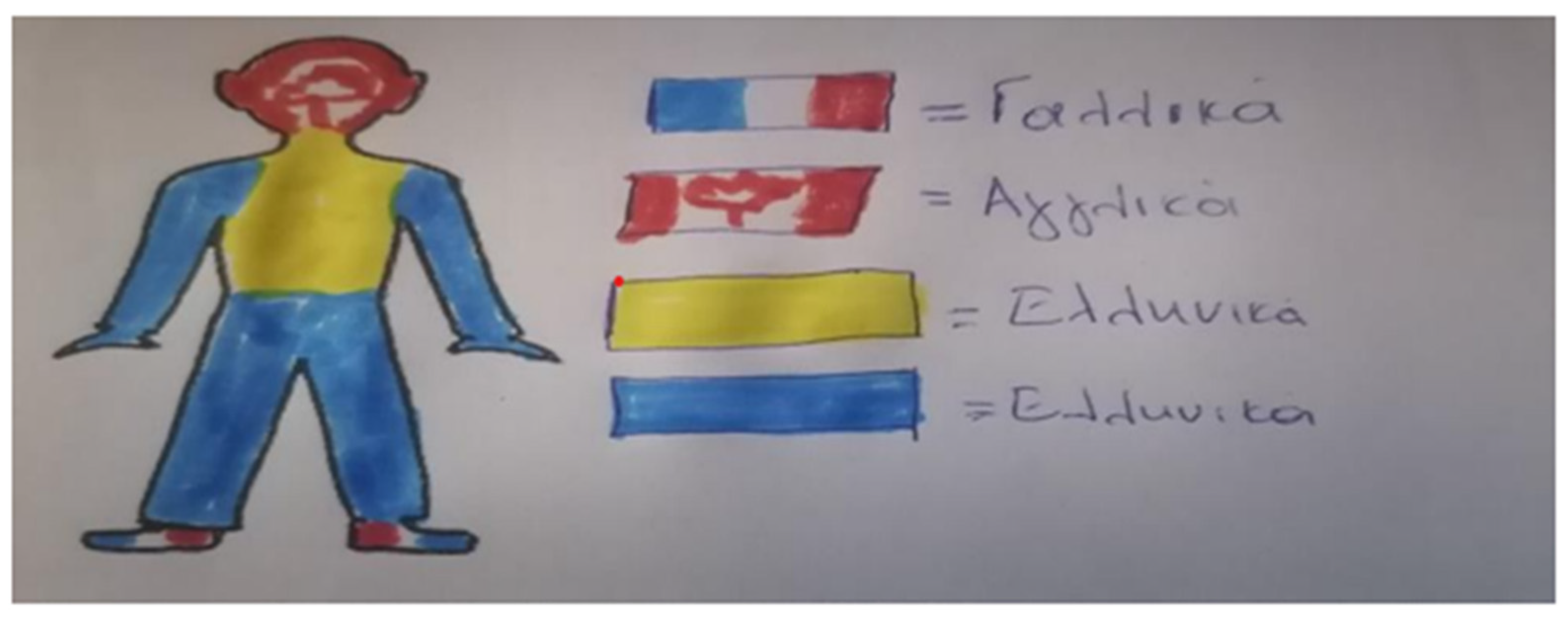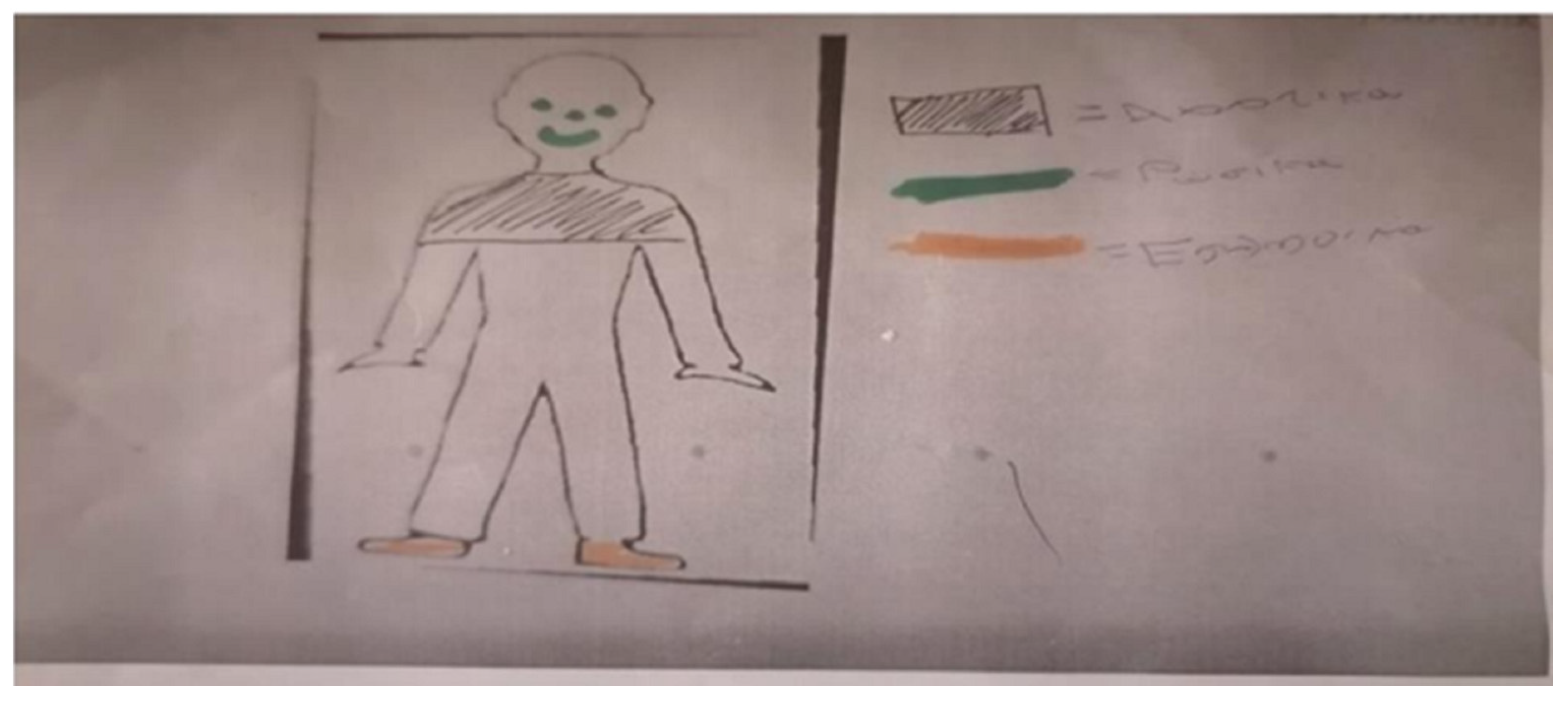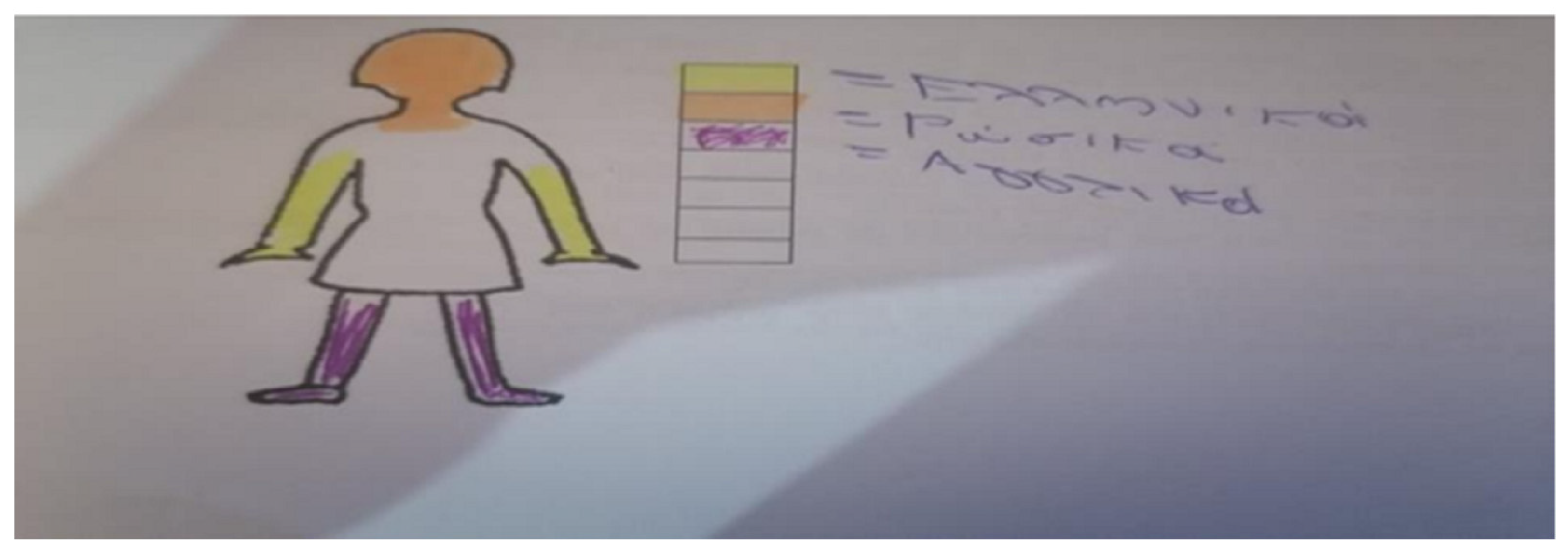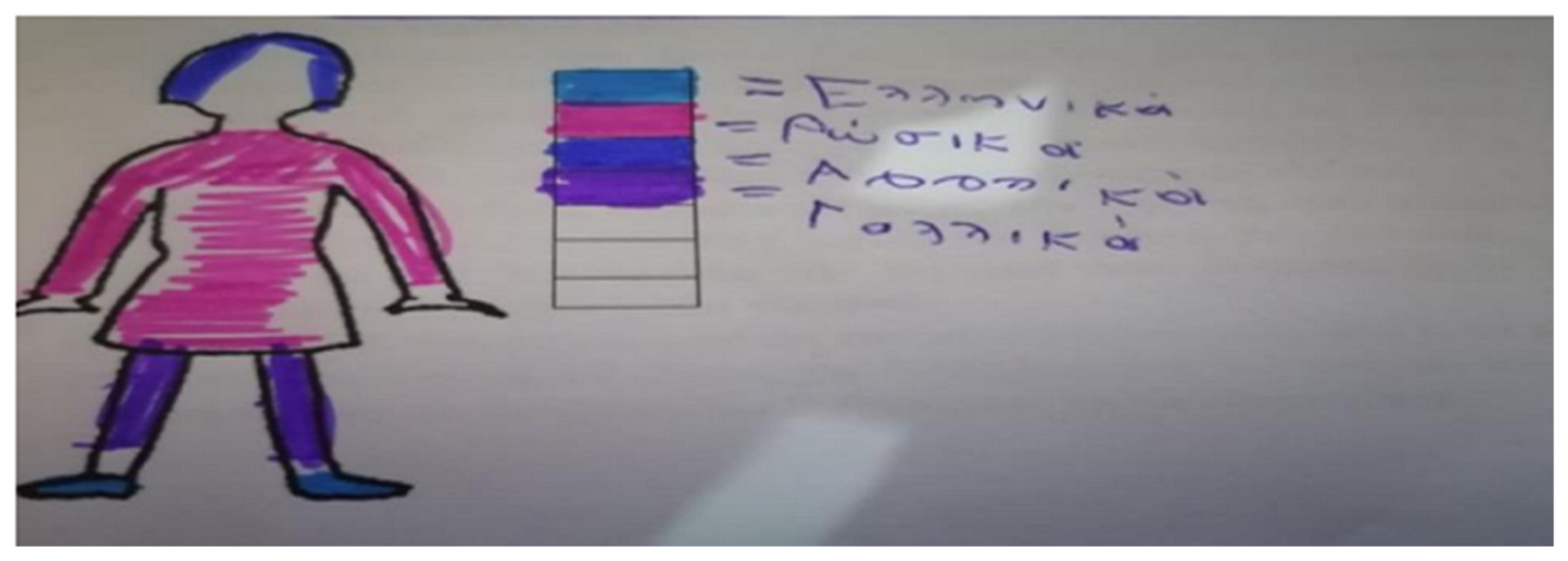Exploring Migrant Students’ Attitudes towards Their Multilingual Identities through Language Portraits
Abstract
1. Introduction
2. Materials and Methods
3. Results
3.1. Participants’ Visual Representations of Their Linguistic Repertoires
3.1.1. Participants’ Color Choices
Flags
- I:
- Why did you choose red to represent Albanian? P3.E: Red is on the Albanian flag.
- P4.A:
- Why on the flag that Albania has... it is red. P8.M: Because the Russian flag is red...I like red...as I do for the Russian language. P10.L: As you can see…. I tried to draw the flag of Canada.
World Knowledge and Personal Experience
- I:
- Why did you choose yellow to represent Greek?
- P7.M:
- Because Greece has a lot of sun and that’s why I chose yellow, which is like the sun.
- P9.A:
- Because Greece has a lot of sun.
- I:
- Why did you choose blue to represent Greek?
- P2.A:
- Blue is the sea of Greece.
- I:
- Why did you choose green to represent Russian?
- P9.A:
- Because Russia has forests.
- I:
- Why did you choose orange to represent Russian?
- P7.M:
- Oh, now it’s a bit hard to explain, because in Russia at Christmas every
Emotions
- I:
- Why did you choose pink to represent Russian?
- P2.A:
- Pink is my favorite color, and so is the Russian language.
- P4.A:
- Red for Albanian and my favorite color.
- P8.M:
- Because the Russian flag is red...I like red...as I do for the Russian language (see also Figure 5 below).
3.1.2. Participants’ Language Placements
Attachment
- I:
- Why did you choose red to represent Albanian?
- P3.E:
- Red is on the Albanian flag.
- I:
- What does it mean that you painted Albanian on your little head?
- P3.E:
- Although I grew up in Greece, I think like an Albanian....to keep them in mind (see also Figure 6 below).
- I:
- Why did you choose pink to represent Russian?
- P2.A:
- Pink is my favorite color.
- I:
- What feelings arise when you think about your L1? Is your L1 important for you?
- P2.A:
- I love Russian; for me, it’s mom and dad.
Body Functions
- I:
- What does painting Greek on your little hands mean?
- P3.E:
- I do things with my hands in Greek and I write at school.
- P5.O:
- Greek helps me get along with the kids at school.
- P7.M:
- Because all the lessons we do at school are in Greek, and I do all this with my hands that is, I write with my hands... that’s why I chose hands.
- I:
- What does painting Greek on your little feet mean?
- P8.M:
- Because I know Greek less but also because I also walk in Greece.
- I:
- What does painting Russian on your mouth mean?
- P9.A:
- I can speak Russian better than Greek.
3.2. Students’ Perceptions of Multilingualism and Emotions
- I:
- What feelings arouse when you think about your L1?
- P6.I:
- “I feel love; I feel my cousins and uncles who also speak Albanian”.
- I:
- Is your L1 important for you?
- P1.M:
- A lot. With mom and dad, we speak Bulgarian so that I don’t forget them. When I go to Bulgaria, I want to be able to speak.
4. Discussion
Author Contributions
Funding
Institutional Review Board Statement
Informed Consent Statement
Data Availability Statement
Conflicts of Interest
References
- Adami, E. Multimodality and superdiversity: Evidence for a research agenda. In Tilburg Papers in Culture Studies; Working Paper; Babylon Center for the Study of Superdiversity, Tilburg University: Tilburg, The Netherlands, 2017; Volume 177. [Google Scholar]
- UNICEF. A World Ready to Learn: Prioritizing Quality Early Childhood Education: Global Report; UNICEF: New York, NY, USA, 2019; Available online: https://bit.ly/migrationgov2022 (accessed on 3 February 2023).
- FRA. Fundamental Rights of Migrants in an Irregular Situation in the European Union; Publications Office of the European Union: Luxembourg, 2011; Available online: https://www.unicef.org/sites/default/files/2019-08/A-world-ready-to-learn-2019.pdf (accessed on 3 February 2023).
- González, N.; Moll, L.C.; Amanti, C. Funds of Knowledge: Theorising Practices in Households, Communities and Classrooms; Laurence Erlbaum Associates: Mahwah, NJ, USA, 2005. [Google Scholar]
- Chumak-Horbatsch, R. Linguistically Appropriate Practice. A Guide for Working with Young Immigrant Children; University of Toronto Press: Toronto, ON, Canada, 2012. [Google Scholar]
- Cummins, J. Language, Power and Pedagogy: Bilingual Children in the Crossfire; Multilingual Matters: Bristol, UK, 2004. [Google Scholar]
- Adam, S.H.; Paris, D. Culturally Sustaining Pedagogies: Teaching and Learning for Justice in a Changing World; Teachers College Press: New York, NY, USA, 2017. [Google Scholar]
- Busch, B. The Language Portrait in Multilingualism Research: Theoretical and Methodological Considerations. Work. Pap. Urban Lang. Literacies 2018, 236, 1–13. [Google Scholar]
- Dressler, R. Exploring Linguistic Identity in Young Multilingual Learners. TESOL Can. J. 2015, 32, 452. [Google Scholar] [CrossRef]
- Krumm, H.J. Multilingualism and Subjectivity: Language Portraits, by Multilingual Children. In Handbook of Multilingualism and Multiculturalism; Zarate, G., Lévy, D., Kramsch, C., Eds.; Archives Contemporaines: Paris, France, 2011; pp. 101–104. [Google Scholar]
- Melo-Pfeifer, S. Multilingual Awareness and Heritage Language Education: Children’s Multimodal Representations of Their Multilingualism. Lang. Aware. 2015, 24, 197–215. [Google Scholar] [CrossRef]
- Melo-Pfeifer, S. Drawing the Plurilingual Self: How Children Portray Their Plurilingual Resources. Int. Rev. Appl. Linguist. Lang. Teach. 2017, 55, 41–60. [Google Scholar] [CrossRef]
- Soares, C.T.; Duarte, J.; Günther-van der Meij, M. ‘Red is the color of the heart’: Making young children’s multilingualism visible through language portraits. Lang. Educ. 2020, 35, 22–41. [Google Scholar] [CrossRef]
- Prasad, G. Portraits of Plurilingualism in a French International School in Toronto: Exploring the Role of Visual Methods to Access Students’ Representations of Their Linguistically Diverse Identities. Can. J. Appl. Linguist. 2014, 17, 51–77. [Google Scholar]
- Busch, B. The linguistic repertoire revisited. Appl. Linguist. 2012, 33, 503–523. [Google Scholar] [CrossRef]
- Kress, G.; Van Leeuwen, T. Reading Images: The Grammar of Visual Design; Routledge: London, UK, 2006. [Google Scholar]
- Lau, S.M.C. Language, identity, and emotionality: Exploring the potential of language portraits in preparing teachers for diverse learners. New Educ. 2016, 12, 147–170. [Google Scholar] [CrossRef]
- Schwarz, L.; Vetter, E.; Janik, M. Schools as Linguistic Space: Multilingual Realities at Schools in Vienna and Brno. In Challenging Boundaries in Language Education; Kostoulas, A., Ed.; Springer: London, UK, 2019; pp. 211–228. [Google Scholar]
- Papadaki, A. Linguistic Views and Practices Regarding Bilingualism in Albanian Immigrant Families: A Case Study on the Island 474 of Hydra. Master’s Thesis, Hellenic Open University, Patra, Greece, 2022. Available online: https://apothesis.eap.gr/archive/item/169263?lang=en (accessed on 14 March 2023).
- Yilmaz, B. 9 Language and Humanitarian Governmentality in a Refugee Camp on Lesvos Island. In Exploring (Im) Mobilities: Language Practices, Discourses and Imaginaries; Multilingual Matters: Bristol, UK, 2022. [Google Scholar]
- Gkaintartzi, A.; Gkountani, G.; Kamaretsou, A.; Kokkini, C.; Sakellaridi, K.; Sireti, A. Understanding the “Voices” of Children of Immigrant and Refugee Backgrounds. Int. J. Divers. Educ. 2020, 20, 37–55. [Google Scholar] [CrossRef]
- Busch, B. School Language Profiles: Valorizing Linguistic Resources in Heteroglossic Situations in South Africa. Lang. Educ. 2010, 24, 283–294. [Google Scholar] [CrossRef]
- Bryman, A. Social Research Methods; Oxford University Press: London, UK, 2016. [Google Scholar]






| Languages Spoken | |||||||
|---|---|---|---|---|---|---|---|
| Participants | Age | Gender | Years in Greece | Country of Origin | L1 | L2 | Foreign Languages |
| P1.M | 8 | girl | 7 | Turkey | Turkish–Bulgarian | Greek | English |
| P2.A | 8 | girl | 4 | Latvia (mother)—Greece (father) | Russian | Greek | English |
| P3.E | 10 | boy | 10 | Albania | Albanian | Greek | English–German |
| P4.A | 10 | boy | 10 | Albania | Albanian | Greek | English–German |
| P5.O | 12 | girl | 12 | Albania | Albanian | Greek | English |
| P6.1 | 11 | boy | 11 | Albania | Albanian | Greek | English |
| P7.M | 11 | girl | 5 | Russia | Russian | Greek | English |
| P8.M | 13 | boy | 5 | Russia | Russian | Greek | English |
| P9.A | 12 | boy | 1 | Russia | Russian | Greek | English |
| P10.L | 12 | boy | 12 | Canada | English | Greek | French |
Disclaimer/Publisher’s Note: The statements, opinions and data contained in all publications are solely those of the individual author(s) and contributor(s) and not of MDPI and/or the editor(s). MDPI and/or the editor(s) disclaim responsibility for any injury to people or property resulting from any ideas, methods, instructions or products referred to in the content. |
© 2023 by the authors. Licensee MDPI, Basel, Switzerland. This article is an open access article distributed under the terms and conditions of the Creative Commons Attribution (CC BY) license (https://creativecommons.org/licenses/by/4.0/).
Share and Cite
Stavrakaki, A.; Manoli, P. Exploring Migrant Students’ Attitudes towards Their Multilingual Identities through Language Portraits. Societies 2023, 13, 153. https://doi.org/10.3390/soc13070153
Stavrakaki A, Manoli P. Exploring Migrant Students’ Attitudes towards Their Multilingual Identities through Language Portraits. Societies. 2023; 13(7):153. https://doi.org/10.3390/soc13070153
Chicago/Turabian StyleStavrakaki, Antonia, and Peggy Manoli. 2023. "Exploring Migrant Students’ Attitudes towards Their Multilingual Identities through Language Portraits" Societies 13, no. 7: 153. https://doi.org/10.3390/soc13070153
APA StyleStavrakaki, A., & Manoli, P. (2023). Exploring Migrant Students’ Attitudes towards Their Multilingual Identities through Language Portraits. Societies, 13(7), 153. https://doi.org/10.3390/soc13070153







